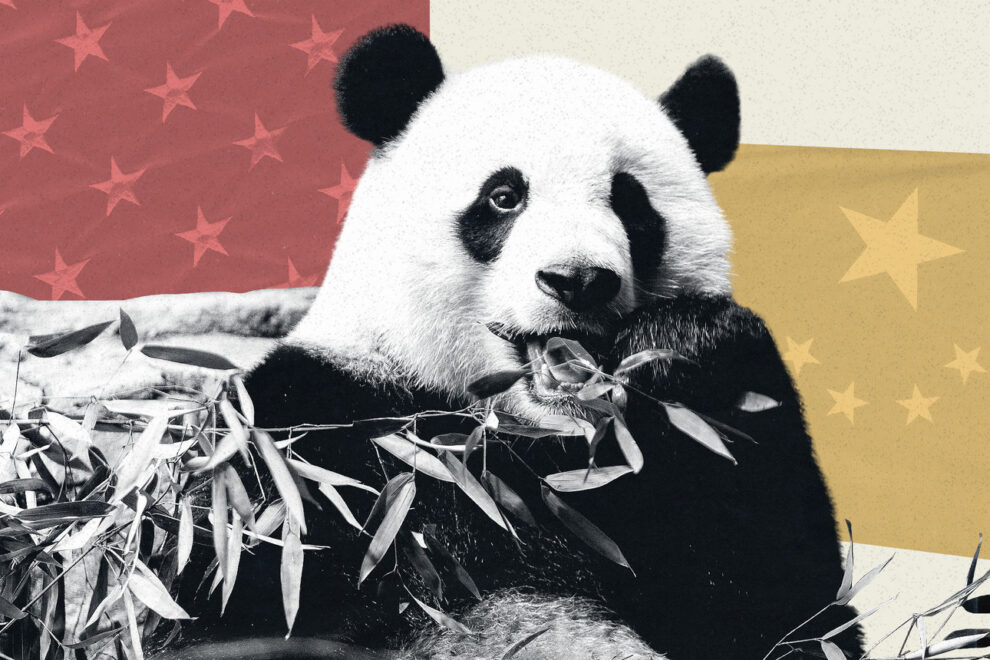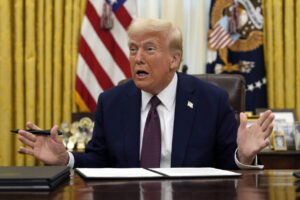What it means that China is taking back the D.C. icons.
When the last of the National Zoo’s giant pandas is shipped back to China this fall, Washington will say goodbye to one of its most popular tourist attractions. It’ll also mark the departure of a living, breathing, bamboo-chomping international-relations metaphor — a history that begins with a cuddly gift at a triumphal inflection point in the last Cold War, and may now be ending with an empty panda house at the anxious dawn of the new one.
Officially, the bears are leaving because the lease is up. But the Smithsonian is mum about prospects for replacements, as well as about why negotiations for a new lease fizzled. And their decision to hold the weeklong “Panda Palooza” farewell festival that concluded last Sunday makes it look like they don’t expect a quick return of an animal that had come to represent the zoo itself.
In the beginning, it was all about optimism and goodwill. The black-and-white giants arrived in the heady days that followed President Richard Nixon’s dramatic 1972 opening to China. During the visit, Pat Nixon had been sitting next to Zhou Enlai at a banquet and remarked that the pandas on the Chinese premier’s cigarette tin were awfully cute. “I’ll give you some,” Zhou replied.
The first lady may not have known it, but the species was freighted with significance for the Communist government. Because pandas hadn’t been part of the iconography of the old imperial court, the uniquely Chinese animal became an acceptable way of expressing national pride under the People’s Republic. By the time of the cultural revolution, they were ubiquitous in consumer brands and officially sanctioned art, according to Elena Songster, a historian who has written a book-length political history of the species. “Panda diplomacy” was also a useful PR tool.
Within two months of that dinner with the Nixons, Hsing-Hsing and Ling-Ling had landed at Andrews Air Force Base en route to the zoo, history’s most adorable diplomatic gesture. More than 20,000 people came to see the 18-month-olds on their first weekend. The president himself came to the welcome party, embracing the pandas as an emblem of his historic statecraft — and a bona fide popular sensation where lines to see the exhibit could be an hour deep.

(The American reciprocal gift wasn’t quite so sensational: A pair of musk oxen whose provenance wasn’t even mentioned on the plaque at Beijing’s zoo. One of them soon died, a fact that was discovered only when U.S. envoy George H.W. Bush visited the facility in 1975 and asked to see it. His request was greeted with an awkward silence.)
In the Washington of my childhood, on the other hand, the pandas were everywhere: On D.C. tourist T-shirts, on farecards for the new Metrorail system, on the logo for the zoo’s own fundraising group. Though the American capital is 8,000 miles from a panda’s actual habitat, the animals weirdly became a symbol of Washington itself. Local media covered them like celebrities, right down to their favorite foods. (Hsing-Hsing liked blueberry muffins).
The most breathless attention was devoted to the bears’ fertility, which was covered as if they were members of a royal family trying to produce an heir. Alas, it didn’t go well: At first, zookeepers worried that the bears, plucked from the wild at a young age, didn’t actually know how to mate. When they finally did, their luck was terrible. Starting in 1983, five cubs in five years were either stillborn or died in infancy. Attempts at artificial insemination were also unsuccessful.
This wasn’t the only sign that it wasn’t all happily ever after. The rare observer who wasn’t overwhelmed by panda cuteness could see that the beloved animals behaved in ways that were somewhat less than adorable. They didn’t seem to like one another very much. Or others. Ling-Ling assaulted a zookeeper. A panda brought from the London zoo in hopes of mating with Ling-Ling mauled her instead. One of the cub fatalities came after Ling-Ling sat on the newborn.
Not that Washington noticed. In the public mind, pandas were still big, clumsy and goofy — among the good guys of the zoological world. When Ling-Ling died suddenly in 1992, the news was on the front page of the Washington Post. When Hsing-Hsing died after a long illness seven years later at the remarkable age of 28, leaving the panda house empty, a sort of civic mourning ensued, with a media deluge that included coverage of his final meals (he only wanted Starbucks blueberry muffins, naturally).
In a panda-smitten American capital, there was no doubt that the animals would be replaced. But it wasn’t 1972 anymore. China was no longer an impoverished giant stumbling out of isolation — and Sino-American relations were no longer all about crafty triangulation against a mutual foe. There are fewer than 2,000 pandas left. Like good stewards of a rising economic behemoth, Chinese officials knew just what to do when you have a monopoly on a scarce resource: Demand top dollar and drive tough terms.
So when Mei Xiang and Tian Tian arrived in 2000, the new pandas were no gift. They were a pricey financial transaction. The zoo would be renting the pandas from the China Wildlife Conservation Association for 10 years at a price of $10 million. Under the terms of the arrangement, which called for Smithsonian and Chinese scientists to work jointly on research and breeding of the endangered species, any cub the pair produced would remain Chinese property.

The terms were fairly standard. Panda diplomacy had stopped being about a revolutionary government gifting the rare cuties to its friends. It was now about an emerging WTO member striking lucrative rental arrangements all over the world — deals that wouldn’t have to be renewed should the situation change. Other American zoos got in on the action, too, meaning the pandas in Washington were no longer quite such a unique attraction. Even cuddly zoo animals, it seemed, reflected a ballooning trade deficit.
The throngs at the zoo, though, didn’t appear too vexed about the geopolitics. Washington still loved its pandas, whatever their legal status. Some 150 panda statues appeared on D.C. streets as part of a public art project. The WNBA’s Washington Mystics basketball squad introduced Pax the Panda as its mascot. David Rubenstein, the billionaire founder of the politically connected Carlyle Group, donated millions to the program and got his name on the panda house in return. The zoo launched a “panda cam” livestream: A video of one of the bears frolicking in a 2016 blizzard racked up 93 million views.
The new couple also managed to conceive several times, with the birth of each cub registering as a news event. During a state visit in Washington, Chinese first lady Peng Liyuan and Michelle Obama jointly announced the naming of one of them, Bei Bei. Under the terms of the rental, Bei Bei was ultimately sent back to China, just like siblings Tai Shan and Bao Bao. The zoo threw farewell celebrations each time. (The youngest of the family, Xiao Qi Ji, the first panda born via artificial insemination outside China, is still here, slated to leave with his parents.)
Even as relations between the governments grew frostier, new versions of the 2000 deal between the zoo and the Chinese wildlife organization were signed in 2010 and again in 2015. The most recent pact was extended at the end of the Covid-ridden 2020, during which the zoo was closed for a chunk of time. But the extension was for only three years.
By that point, negotiations were taking place against the backdrop of an American political scene in which anti-China sentiments were running hot — and a Chinese context where resentment of alleged U.S. lecturing made leaders ever less interested in touchy-feely gestures.

Particularly on the populist right, there’s a tendency to view the last few decades of deal-making with China as a story of naive Americans being snookered by an autocratic regime. Last year, in the House of Representatives, that sentiment finally attached itself to the pandas. The Promoting Animal Naturalization and Democracy Act (PANDA — get it?), introduced by South Carolina Republican Nancy Mace, condemned panda leases, directing the U.S. to establish a rival panda-breeding program with allies. It also said that pandas born in the U.S. should stay here.
“For too long, the Chinese Communist Party has attempted to soften its image with that of the soft cuddly panda by loaning giant pandas to foreign countries at a fee of $500,000 per panda. All countries must agree to return the pandas to China, property of the Communist Chinese government. Let’s get serious with our diplomacy, and hit China where it hurts,” Mace said in a floor speech that mentioned the Wuhan Covid outbreak and the treatment of the Uyghur minority.
In a line that may have flummoxed zookeepers guarding the pandas’ cages in Washington, Mace also implored Congress to “give freedom to the pandas and allow pandas born in the United States to stay in the United States.”
The measure went nowhere, but it was a pretty good example of our era’s background music. Did it blow up chances for a new lease? Unclear. Panda loans to local zoos also ended in Memphis and San Diego. A State Department spokesperson reiterated to me that the deal between the National Zoo and the China Wildlife Conservation Association wasn’t a government-to-government contract. But as a trust created and funded by the federal government, the Smithsonian is led by folks who tend to worry about getting hauled before Congress and accused of appeasing an enemy.
This summer, it became clear that no one on either side was doing any appeasing: The zoo announced that the contract would expire at year’s end. In a neat final bit of symbolism, the much-hyped farewell program, which included warm cultural-exchange activities like Chinese calligraphy lessons for kids and food from the Chinese Embassy, was sponsored by Boeing, an American firm that actually needs to sell things in China.

In another reminder of the political state of play, the celebration’s final day was nearly canceled by a government shutdown that would have caused the zoo to shut its doors. When a last-minute deal averted the shutdown, locals got one last chance to say goodbye. Mei Xiang, Tian Tian and little Xiao Qi Ji will leave before winter.
So will geopolitics mean the next generation of Beltway kids will grow up in a panda-less city? It seems so. But at least a few China-watchers I spoke to said they could imagine a plausible optimistic scenario. Both the Biden administration and the Chinese government have lately moved to tamp down the showy hostility. A string of U.S. officials have visited China; the president has said he expects to meet Xi Jinping before year’s end, possibly at November’s APEC summit in San Francisco. Announcing a panda deal would be the kind of thing that could lend at least a patina of comity to the tense interaction.
It would still be a bleak piece of symbolism, though — and a far cry from either the sensational gift of 1972 or the cold cash exchange of 2000: With intractable disagreements about life-and-death issues like Ukraine, Taiwan, human rights and democracy, unveiling a new rent-a-bear would be less about strategic friendship than crisis management. It would be the very least anyone could do.
And you can bet that no president will be on hand to welcome the new pandas if they ever arrive.
Source : Politico










